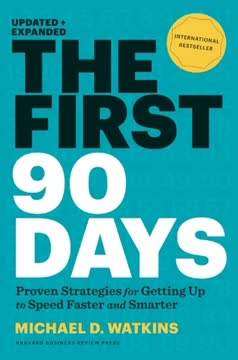Key Takeaways
1. Embrace Personal Disruption to Accelerate Growth
Disrupt yourself is critical to avoiding stagnation, being overtaken by low-end entrants (i.e., younger, smarter, faster workers), and fast-tracking your personal and career growth.
The S-curve model explains personal disruption. At the base of the curve, progress is slow as you learn new skills. As you gain competence, you enter a phase of hypergrowth, rapidly scaling to new heights. Eventually, you plateau, signaling it's time to jump to a new curve.
Benefits of personal disruption:
- Prevents stagnation
- Keeps you ahead of competition
- Accelerates personal and career growth
- Leads to unexpected opportunities
To disrupt yourself, identify unmet needs in your field, match them with your distinctive strengths, and be willing to take calculated risks. This process often involves stepping back or sideways in your career to ultimately move forward.
2. Take Calculated Risks to Drive Innovation
Market risk is less risky than competitive risk.
Distinguish between competitive and market risk. Competitive risk involves entering established markets with proven technologies, while market risk involves creating new markets for unproven ideas.
Key points about risk-taking:
- Market risk offers higher potential rewards
- 37% of firms entering new markets surpassed $100 million in revenue, compared to only 6% in established markets
- New markets generated $62 billion in accumulated revenue, versus $3.3 billion for established markets
To take smart risks:
- Identify unmet needs in your industry
- Assess your unique skills and experiences
- Look for opportunities where no one else is playing
- Be willing to start small and scale up
3. Leverage Your Distinctive Strengths
A distinctive strength is something that you do well that others within your sphere don't.
Identify your unique talents by asking yourself:
- What skills have helped you survive?
- What makes you feel strong?
- What exasperates you about others?
- What made you different as a child?
- What compliments do you shrug off?
- What are your hard-won skills?
Once identified, match your strengths with unmet needs in your field. This combination allows you to create unique value and accelerate up your learning curve.
Examples:
- A neuroscientist becoming a naval aerospace psychologist
- A lawyer leveraging social media skills to become a partner at 32
4. Turn Constraints into Catalysts for Creativity
The more constraints one imposes, the more one frees one's self.
Embrace constraints as they:
- Lead to faster feedback
- Help solve one variable at a time
- Improve focus
- Foster creativity
Types of constraints to consider:
- Money
- Knowledge
- Time
Strategies for leveraging constraints:
- Move from victim to transformer mindset
- Break path dependence
- Ask propelling questions
- Reframe to "can-if"
- Seek new sources of abundance
- Activate emotions
Examples of successful constraint-driven innovation:
- NASA's LCROSS mission using off-the-shelf technology
- Dr. Seuss writing "The Cat in the Hat" using only 225 words
5. Combat Entitlement to Foster Innovation
Entitlement, the belief that something is owed to you by life, comes in many guises, and it is on the rise.
Types of entitlement:
- Cultural entitlement
- Emotional entitlement
- Intellectual entitlement
Strategies to overcome entitlement:
- Cultural: Immerse yourself in new cultures and open networks
- Emotional: Practice gratitude and express thanks
- Intellectual: Listen to dissenting voices and practice humble inquiry
Benefits of overcoming entitlement:
- Increased innovation
- Better decision-making
- Improved relationships
- Enhanced personal growth
6. Step Down, Back, or Sideways to Grow
Sometimes the only way up is down.
Benefits of strategic career moves:
- Access to new learning curves
- Opportunity to develop new skills
- Potential for greater long-term success
Considerations for stepping back:
- Assess your current growth trajectory
- Identify skills gaps
- Evaluate potential long-term benefits
- Prepare financially and emotionally
Examples of successful backward moves:
- Dave Blakely moving from engineer to program manager at IDEO
- Carine Clark taking a pay cut to become CEO of a smaller company
7. Learn from Failure to Fuel Success
Failure itself doesn't limit dreaming and personal innovation—shame does.
Strategies for dealing with failure:
- Recognize failure is inevitable
- Redefine success
- Acknowledge and share sadness
- Jettison shame
- Learn from the experience
- Know when to quit
To extract value from failure:
- Ask: "What valuable truth did you discover about your present and future prospects?"
- Apply the "five whys" technique to understand root causes
- Use failure as a catalyst for growth and innovation
8. Adopt a Discovery-Driven Approach to Career Planning
With discovery-driven planning, you begin with the premise that little is known and much is assumed.
Key steps in discovery-driven planning:
- Create a reverse income statement
- Calculate the cost
- Compile an assumption checklist
- Prepare a milestone chart
Benefits of this approach:
- Flexibility to adapt to new information
- Ability to test assumptions
- Increased likelihood of finding unexpected opportunities
Examples of discovery-driven careers:
- Linda Descano evolving from geologist to head of social media at Citigroup
- Tom McGuire transitioning from accounting to business intelligence
Remember: You can't see the top of the curve from the bottom. Be open to unexpected opportunities and be willing to adapt your plan as you learn and grow.
Last updated:
FAQ
What's "Disrupt Yourself" about?
- Core Concept: "Disrupt Yourself" by Whitney Johnson explores the idea of applying the principles of disruptive innovation to personal growth and career development. It encourages individuals to take control of their career paths by embracing change and innovation.
- S-Curve Model: The book uses the S-curve model to explain how individuals can navigate their personal and professional growth, highlighting the stages of learning, mastery, and plateau.
- Seven Variables: Johnson identifies seven key variables that can accelerate or decelerate personal growth, including taking the right risks, playing to your strengths, and embracing constraints.
Why should I read "Disrupt Yourself"?
- Practical Guidance: The book offers practical advice for individuals looking to innovate in their careers and avoid stagnation, making it a valuable resource for anyone seeking personal or professional growth.
- Counterintuitive Insights: Johnson provides counterintuitive insights into how taking risks and embracing constraints can lead to greater success and fulfillment.
- Inspiration from Real Stories: The book includes inspiring stories and examples from various industries and individuals who have successfully disrupted themselves.
What are the key takeaways of "Disrupt Yourself"?
- Embrace Disruption: Embracing disruption in your career can lead to unexpected success and personal growth.
- S-Curve Understanding: Understanding the S-curve model helps individuals navigate the phases of learning and mastery in their careers.
- Seven Variables: The seven variables identified by Johnson—such as taking the right risks and battling entitlement—are crucial for accelerating personal growth.
How does Whitney Johnson define "disruptive innovation" in personal growth?
- Low-End Disruption: Johnson applies the concept of low-end disruption, where individuals start at the bottom and work their way up, often in unexpected ways.
- New-Market Disruption: She also discusses new-market disruption, where individuals create new opportunities for themselves by identifying unmet needs.
- Personal S-Curve: The personal S-curve is used to illustrate how individuals can manage their growth and transitions effectively.
What is the S-curve model in "Disrupt Yourself"?
- Stages of Growth: The S-curve model outlines the stages of growth, including the initial slow progress, rapid growth, and eventual plateau.
- Learning and Mastery: It emphasizes the importance of continuous learning and mastery to avoid stagnation and remain competitive.
- Navigating Transitions: The model helps individuals understand how to navigate transitions and jump to new curves for continued growth.
What are the seven variables that Whitney Johnson identifies for personal growth?
- Right Risks: Taking the right risks is essential for personal growth and innovation.
- Distinctive Strengths: Playing to your distinctive strengths allows you to stand out and succeed.
- Embrace Constraints: Embracing constraints can lead to faster feedback and more creative solutions.
- Battle Entitlement: Battling entitlement is crucial to maintaining a growth mindset and avoiding stagnation.
- Step Back to Grow: Sometimes stepping back or sideways is necessary for long-term growth.
- Give Failure Its Due: Learning from failure is a critical component of personal development.
- Driven by Discovery: Being driven by discovery allows for flexibility and adaptation in the face of uncertainty.
How does "Disrupt Yourself" suggest handling failure?
- Inevitability of Failure: Johnson emphasizes that failure is inevitable and should be expected as part of the growth process.
- Learning Opportunity: Failure should be viewed as a learning opportunity, providing valuable insights for future success.
- Shame and Vulnerability: The book advises against letting failure lead to shame, instead encouraging vulnerability and openness to growth.
What role do constraints play in "Disrupt Yourself"?
- Creative Solutions: Constraints can lead to more creative solutions by forcing individuals to think outside the box.
- Faster Feedback: They provide faster feedback, allowing for quicker adjustments and improvements.
- Focus and Clarity: Constraints help maintain focus and clarity by limiting options and reducing complexity.
How does Whitney Johnson address entitlement in "Disrupt Yourself"?
- Cultural Entitlement: Johnson warns against cultural entitlement, which can lead to stagnation and a lack of innovation.
- Emotional Entitlement: Emotional entitlement, or the belief that one's feelings should be prioritized, can hinder personal growth.
- Intellectual Entitlement: Intellectual entitlement, or resistance to new ideas, can prevent individuals from learning and adapting.
What are some of the best quotes from "Disrupt Yourself" and what do they mean?
- "Playing it safe is not safe in today’s fast-paced marketplace." This quote emphasizes the importance of taking risks to stand out and succeed in a rapidly changing world.
- "The more you disrupt, the better you’ll get at it." This highlights the idea that practice and experience in disruption lead to greater skill and confidence.
- "Constraints keep us grounded, and staying grounded gives us traction." This quote illustrates how constraints can provide the necessary structure and focus for growth.
How does "Disrupt Yourself" suggest identifying your distinctive strengths?
- Survival Skills: Consider the skills that have helped you survive and thrive in challenging situations.
- Feel Strong: Identify activities that make you feel strong and invigorated, as these often align with your strengths.
- Compliments: Pay attention to compliments you receive, especially those you tend to dismiss, as they may reveal hidden strengths.
How can "Disrupt Yourself" help with career transitions?
- Understanding Transitions: The book provides insights into understanding and navigating career transitions using the S-curve model.
- Preparation for Change: It offers strategies for preparing for and embracing change, such as stepping back to grow and redefining success.
- Discovery-Driven Approach: Johnson advocates for a discovery-driven approach to career transitions, allowing for flexibility and adaptation.
Review Summary
Disrupt Yourself receives mixed reviews, with an average rating of 3.73 out of 5. Readers appreciate its insights on personal growth and career development, praising Johnson's application of business disruption principles to individual lives. Many find the book inspiring and practical, offering valuable strategies for embracing change and taking risks. However, some criticize its business-centric focus and lack of depth in certain areas. Overall, readers value the book's encouragement to challenge oneself and pursue continuous learning, though opinions vary on its universal applicability.
Similar Books










Download PDF
Download EPUB
.epub digital book format is ideal for reading ebooks on phones, tablets, and e-readers.





